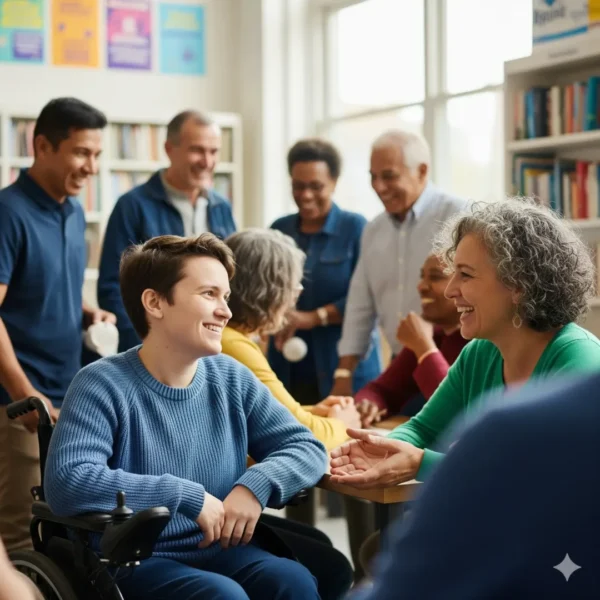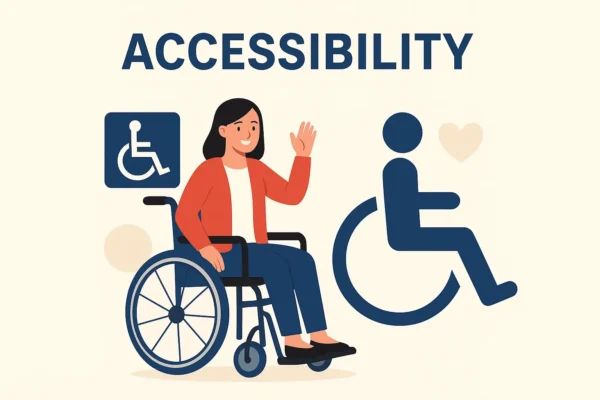Disability and Social Isolation in 2027, disability and social isolation remain a significant and concerning issue in 2027. Despite growing awareness and inclusion efforts, many individuals with disabilities experience loneliness, disconnection, and limited social interaction.
See MOre: International Development and Disability in 2029
Disability Rights: Disability and Social Isolation in 2027

Disability rights encompass the civil, political, economic, and social rights of people with disabilities. It’s about ensuring equal opportunities and participation for everyone, regardless of ability. Here’s a breakdown of key aspects:
- Equal Access: People with disabilities deserve equal access to education, employment, transportation, healthcare, and all aspects of community life. This includes physical accessibility through ramps, elevators, and accessible restrooms, as well as communication accessibility through sign language interpreters, captioning, and Braille.
- Inclusion and Participation: Disability rights advocates fight for the inclusion of people with disabilities in decision-making processes and all areas of society. This means creating inclusive environments where people with disabilities feel valued and empowered to contribute their talents and perspectives.
- Non-Discrimination: Discrimination based on disability is illegal. Disability rights laws protect individuals from being denied opportunities or facing unequal treatment in employment, housing, education, and other areas.
- Independent Living: People with disabilities deserve to live independently and make their own choices. This means promoting accessible housing options, personal care assistance, and support services that enable individuals to live with dignity and autonomy.
The Importance of Disability Rights:
- Fairness and Justice: Disability rights ensure everyone has the chance to reach their full potential and contribute to society.
- Economic Empowerment: When people with disabilities have equal access to education and employment, it strengthens the economy and benefits everyone.
- Innovation and Progress: A diverse and inclusive society fosters creativity and innovation, leading to better solutions for everyone.
The Road Ahead:
The fight for disability rights is ongoing. We must continue to:
- Raise Awareness: Educating the public about disability rights is crucial for building a more inclusive world.
- Advocate for Change: Supporting disability rights organizations and policies is essential to achieve lasting progress.
- Embrace Diversity: Celebrating disability as a part of human experience fosters greater empathy and understanding.
Together, we can create a world where everyone has the opportunity to thrive, regardless of ability.
Social Isolation

- Social isolation, the lack of social connection and meaningful relationships, is a critical issue affecting people of all ages. While often associated with older adults, it can impact anyone, anywhere.
What is Social Isolation?
Social isolation differs from loneliness, which is the feeling of being alone or disconnected despite social contact. Isolation refers to the actual lack of social connections and support systems.
Causes of Social Isolation:
Several factors can contribute to social isolation, including:
- Living alone: People living independently, particularly older adults or those in remote areas, may have fewer opportunities for social interaction.
- Chronic illness or disability: Health challenges can limit mobility and participation in social activities.
- Mental health conditions: Anxiety, depression, or social phobias can make it difficult to build relationships.
- Life transitions: Major life changes like retirement, divorce, or loss of a loved one can disrupt social networks.
- Technological dependence: While technology offers connection, excessive reliance on it can replace face-to-face interactions.
Impacts of Social Isolation:
Social isolation has a significant impact on both mental and physical health. It can increase the risk of:
- Depression and anxiety
- Cognitive decline
- Weakened immune system
- Chronic health problems
- Early mortality
Combating Social Isolation:
The good news is that social isolation is preventable and manageable. Here’s how:
- Build and maintain relationships: Connect with friends, family, and neighbors.
- Join social groups or activities: Find common interests through clubs, volunteer work, or community centers.
- Embrace technology responsibly: Use video calls, social media (in moderation) to connect with others.
- Seek professional help: If social isolation is due to mental health concerns, therapy can be beneficial.
Social Connection A Vital Piece of Health

Social connection is a fundamental human need. By understanding the risks of social isolation and taking steps to combat it, we can promote healthier and happier lives for everyone.
Mental Health and Disability
Mental health is an essential aspect of overall well-being, and it can significantly impact a person’s experience with disability. This section explores this critical intersection.
Co-occurrence of Mental and Physical Disabilities:
- Many individuals with physical disabilities also experience mental health conditions like anxiety, depression, or post-traumatic stress disorder (PTSD). These can be caused by chronic pain, social isolation, or the challenges of adapting to limitations.
- Conversely, some mental health conditions can manifest as physical symptoms, blurring the lines between the two.
Impact on Daily Living:
- Mental health challenges can make managing a physical disability even more difficult. Anxiety or depression can lead to decreased motivation, making it harder to perform essential tasks or participate in rehabilitation.
- Conversely, the limitations imposed by a physical disability can exacerbate mental health concerns, creating a cyclical negative impact.
Importance of Integrated Care:
- Addressing both mental and physical health needs is crucial. Healthcare professionals should consider the interplay of these factors to develop a holistic treatment plan.
- This might involve a combination of medication, therapy, support groups, and skill-building programs to empower individuals to manage both aspects of their well-being.
Mental Health Resources for People with Disabilities:
- Many mental health organizations offer specialized services and support groups tailored to address the unique needs of people with disabilities.
- Online resources and forums can also provide valuable peer support and information.
Breaking Down Stigma:
- There’s a misconception that people with disabilities are more prone to mental health issues. This is simply not true.
- It’s crucial to combat stigma surrounding both disabilities and mental health to ensure everyone has access to the support they need.
Accessibility

Unveiling Accessibility: Building an Inclusive World
Accessibility is the cornerstone of creating a world where everyone, regardless of ability, can participate fully. It’s about removing barriers and ensuring that people with disabilities can access information, goods, services, and opportunities on an equal basis.
Why is Accessibility Important?
- Social Inclusion: Accessibility fosters a more inclusive society where everyone feels valued and empowered to participate.
- Economic Opportunity: By removing barriers to employment and education, accessibility unlocks the vast potential of the disability community, contributing significantly to the economy.
- Enhanced Quality of Life: Accessibility empowers people with disabilities to live more independent and fulfilling lives.
Key Principles of Accessibility:
- Universality: Design products, environments, and services that are usable by the widest range of people possible, regardless of ability.
- Usability: Ensure everything is user-friendly, considering factors like physical limitations, sensory impairments, and cognitive differences.
- Adaptability: Provide options for customization and adaptation to cater to diverse needs.
- Accessibility Standards: Follow established guidelines like the Web Content Accessibility Guidelines (WCAG) for digital accessibility.
Examples of Accessibility Measures:
- Physical Accessibility: Ramps, elevators, accessible restrooms, and wide doorways in buildings.
- Information Accessibility: Braille signs, audio descriptions, closed captioning, and documents in clear and easy-to-read formats.
- Communication Accessibility: Sign language interpreters, text relay services, and assistive listening devices.
- Digital Accessibility: Websites and apps designed with screen readers and keyboard navigation in mind.
- Transportation Accessibility: Low-floor buses, wheelchair lifts, and accessible train stations.
The Benefits of Accessibility Extend Beyond Disability:
- Improved User Experience: Accessible features often benefit everyone, not just people with disabilities. Think about curb cuts, which are helpful for parents with strollers or people carrying heavy packages.
- Innovation and Creativity: Designing for accessibility often leads to innovative solutions that benefit everyone.
- Societal Progress: Accessibility reflects a commitment to social justice and equality for all.
Moving Forward with Accessibility:
- Advocacy: Raise awareness about the importance of accessibility and advocate for inclusive design practices.
- Education: Educate businesses, organizations, and individuals about accessibility standards and best practices.
- Technology: Embrace technology that can bridge accessibility gaps and empower people with disabilities.
Inclusive Communities

- Assistive Technology
Assistive technology (AT) is a broad term encompassing any device, software, or service that helps people with disabilities overcome functional limitations and participate fully in everyday activities. AT plays a crucial role in promoting independence, dignity, and inclusion for individuals with a wide range of disabilities.
Benefits of Assistive Technology:
- Increased Independence: AT empowers people with disabilities to perform tasks independently, fostering self-reliance and a sense of control.
- Improved Participation: AT allows individuals to engage in activities at home, work, school, and in the community, leading to a more fulfilling life.
- Enhanced Communication: AT bridges communication gaps, enabling people with disabilities to express themselves effectively.
- Learning and Education: AT tools support learning and participation in educational settings for students with disabilities.
- Employment Opportunities: AT helps individuals with disabilities qualify for and succeed in jobs, promoting economic security and social integration.
Types of Assistive Technology:
The vast world of AT encompasses a diverse range of tools and solutions, categorized by their function:
- Mobility Devices: Wheelchairs, walkers, canes, prosthetics, and other equipment to improve mobility and physical independence.
- Communication Aids: Speech-generating devices, augmentative and alternative communication (AAC) tools, and software to support communication for individuals with speech impairments.
- Sensory Aids: Screen readers, magnifiers, hearing aids, and other devices that assist people with visual or hearing impairments.
- Computer Assistive Technology: Specialized keyboards, voice recognition software, adapted mice, and other tools that make computers accessible for people with disabilities.
- Assistive Living Technologies: Smart home devices, environmental control systems, and personal emergency response systems that enhance safety and independence in everyday living.
Funding and Access to AT:
The cost of AT can vary significantly. There are various resources to help individuals access AT, including:
- Government Programs: Some government programs offer financial assistance for purchasing AT devices.
- Non-Profit Organizations: Many non-profit organizations provide AT loans, grants, or equipment donation programs.
- Private Insurance: Some private health insurance plans may cover the cost of certain AT devices.
The Future of Assistive Technology:
The field of AT is constantly evolving, with advancements in artificial intelligence, robotics, and wearable technology opening new doors to even more innovative and personalized solutions.
Tele-health

Tele-health Revolution: Transforming Healthcare Delivery in 2027
Telehealth, also known as telemedicine, is rapidly changing the landscape of healthcare. It utilizes technology to deliver healthcare services remotely, offering a convenient and accessible alternative to traditional in-person visits.
Benefits of Telehealth in 2027:
- · Enhanced Convenience: Imagine getting medical advice from the comfort of your home, work, or even while traveling. Telehealth appointments eliminate commute times and waiting room hassles.
- · Improved Accessibility: Telehealth bridges geographical barriers, making healthcare readily available to people in remote areas or with mobility limitations. This is especially beneficial for individuals managing chronic conditions who require frequent consultations.
- · Streamlined Efficiency: Telehealth consultations can be shorter and more focused compared to traditional visits, allowing healthcare providers to see more patients and optimize their time.
- · Chronic Disease Management: Regular telehealth consultations allow for closer monitoring and management of chronic conditions like diabetes, heart disease, and respiratory illnesses.
- · Mental Health Support: Telehealth provides discreet and convenient access to mental health professionals, making it easier for people to seek help and manage mental health conditions.
How Telehealth Works in 2027:
Telehealth consultations can take various forms, with technology playing a central role:
- · Video Calls: This is the closest experience to a traditional visit, allowing for real-time visual interaction between patients and healthcare providers.
- · Telephone Consultations: Simple concerns or follow-up appointments can be effectively handled over secure phone calls.
- · Secure Messaging Platforms: Patients can exchange text messages and images with healthcare providers for non-urgent concerns or medication refills.
Evolving Landscape of Telehealth Services:
The range of services offered through telehealth is continuously expanding. Here are some prominent examples in 2027:
- · Primary Care: Routine check-ups, medication management, and consultations for minor illnesses can all be effectively conducted virtually.
- · Chronic Disease Management: Regular monitoring and adjustments to treatment plans for diabetes, high blood pressure, or heart disease can be done via telehealth.
- · Mental Health Care: Therapy sessions, medication consultations, and support groups are increasingly offered through secure online platforms.
- · Specialist Consultations: Connect with specialists remotely for specific concerns, reducing travel and wait times for patients.
Is Telehealth Right for You?
While telehealth offers numerous benefits, it’s not a one-size-fits-all solution. Some situations may still require in-person visits for a thorough physical examination or specific procedures.
Discuss with your doctor if a telehealth appointment would be appropriate for your specific needs and health concerns.
The Future of Telehealth:
Telehealth is poised for continued growth, with advancements in technology like wearables and remote monitoring devices holding immense potential. Imagine a future where healthcare is personalized, proactive, and accessible from virtually anywhere. Telehealth is paving the way for this exciting future of healthcare delivery.
Mental Health Services

Supporting Your Mental Wellbeing: A Guide to Mental Health Services
Mental health is an essential part of overall well-being. Just like physical health, mental health needs attention and care. Here’s an overview of mental health services available to help you on your journey towards emotional wellness:
Types of Mental Health Services:
- Individual Therapy: Discuss your challenges and concerns with a qualified therapist in a one-on-one setting. Different therapeutic approaches, like cognitive behavioral therapy (CBT) or interpersonal therapy, can be tailored to your specific needs.
- Group Therapy: Connect and share experiences with others facing similar challenges in a supportive group setting. Group therapy can provide a sense of belonging and valuable peer support.
- Family Therapy: Address family dynamics and communication patterns that may be impacting your mental health. Family therapy can help strengthen family relationships and create a more supportive environment.
- Medication Management: A psychiatrist can assess your needs and prescribe medications, if necessary, to manage symptoms of mental health conditions like depression or anxiety.
- Hospitalization: In some cases, short-term inpatient hospitalization may be needed for individuals experiencing severe mental health crises requiring intensive treatment and monitoring.
Finding the Right Mental Health Professional:
- Consider Your Needs: Identify the type of support you need (individual vs. group therapy, medication management, etc.)
- Research Credentials: Look for professionals licensed in your state and specializing in your specific concerns.
- Explore Online Resources: Psychology Today (https://www.psychologytoday.com/us/therapists) and the American Psychological Association ([invalid URL removed]) offer therapist directories.
- Insurance Coverage: Check with your insurance provider to understand your mental health coverage and any in-network providers.
Additional Support Options:
- Support Groups: Community-based support groups offer a safe space to connect with others facing similar challenges.
- Crisis Hotlines: National hotlines like the National Suicide Prevention Lifeline (988) provide immediate support during moments of crisis.
- Mental Health Apps & Online Resources: While not a replacement for professional help, apps and online resources can offer self-management tools and information.
Disability Advocacy

Disability Advocacy: Empowering Change for an Inclusive World
Disability advocacy is a powerful force for creating a more equitable and inclusive society. It’s about ensuring the rights, needs, and voices of people with disabilities are heard, respected, and acted upon. Here’s a breakdown of what disability advocacy entails:
What is Disability Advocacy?
- Promoting Equality: Advocates work to dismantle barriers that prevent full participation in society. This includes advocating for equal access to education, employment, healthcare, transportation, and public spaces.
- Empowering People with Disabilities: Advocacy empowers individuals with disabilities to self-advocate and become active participants in shaping policies and programs that impact their lives.
- Raising Awareness: Advocates educate the public, policymakers, and service providers about disability issues, fostering understanding and promoting positive change.
Who are Disability Advocates?
- Individuals with Disabilities: Self-advocacy is a crucial aspect of disability rights. Individuals with disabilities can speak for themselves and advocate for their specific needs.
- Family Members and Allies: Friends, family members, and people passionate about disability inclusion can be powerful advocates, lending their voices in support.
- Disability Rights Organizations: National and grassroots organizations work tirelessly on policy advocacy, public education, and legal representation for the disability community.
How Can You Get Involved?
- Educate Yourself: Learn about disability rights, different disabilities, and the needs of the disability community.
- Support Disability-Owned Businesses: Empower entrepreneurs with disabilities by patronizing their businesses.
- Spread Awareness: Challenge stereotypes and misconceptions about disabilities. Share stories, resources, and positive messages in your circles.
- Contact Your Representatives: Advocate for policies that promote disability inclusion by contacting your local and national representatives.
- Volunteer Your Time: Many disability organizations rely on volunteers for various tasks.
The Impact of Disability Advocacy:
Disability advocacy creates a ripple effect of positive change:
- Increased Accessibility: Ramps, elevators, assistive technology, and accessible communication formats become more prevalent.
- Improved Educational Opportunities: Inclusive educational practices ensure all students have the resources and support to succeed.
- Greater Employment Opportunities: Reasonable accommodations and workplace modifications empower individuals with disabilities to thrive in their careers.
- Enhanced Social Inclusion: Public spaces become more accessible, and attitudes shift towards greater acceptance and understanding.
- Social Support Networks
The Power of Connection: Building Strong Social Support Networks
Social support networks are like safety nets woven from the threads of our relationships. They provide emotional comfort, practical assistance, and a sense of belonging, all crucial for our well-being. Here’s why building strong social support networks is essential, especially for individuals with disabilities.
Benefits of Strong Social Support:
- Improved Mental Health: Strong connections can combat loneliness and isolation, reducing stress and depression. Sharing feelings and experiences with supportive people can be incredibly helpful.
- Enhanced Physical Health: Social interaction can boost overall health by lowering blood pressure, reducing the risk of chronic diseases, and encouraging healthy lifestyle choices.
- Increased Independence: A strong network can provide practical assistance with daily tasks, fostering independence and confidence for people with disabilities.
- Empowerment and Advocacy: Supportive networks can offer encouragement, guidance, and advocacy, empowering individuals with disabilities to navigate challenges and achieve their goals.
Building Your Network:
- Reconnect with Old Friends and Family: Reach out to loved ones you haven’t connected with in a while. Even small gestures can rekindle friendships.
- Join Disability Support Groups: Connecting with others facing similar challenges can provide valuable support, shared experiences, and a sense of community.
- Volunteer in Your Community: Helping others is a great way to meet new people, develop skills, and feel connected to your community.
- Explore Online Communities: Online forums and social media groups can offer support and connection for people with specific interests or disabilities.
Maintaining Your Network:
- Make Time for Connections: Regularly schedule time for chats, coffee dates, or activities with friends and family.
- Offer Support to Others: Be there for your loved ones, offer help when needed, and nurture your relationships.
- Embrace New Connections: Be open to meeting new people through shared interests or activities.
Breaking Down the Barriers:
Social isolation can have severe consequences for people with disabilities. It can lead to:
- Increased depression and anxiety
- Worsening physical health
- Reduced sense of belonging
- Limited access to essential resources and support
2027 and Beyond: Building Bridges of Connection
Fortunately, there are promising developments aiming to bridge the social isolation gap for people with disabilities in 2027 and beyond:
- Technology Advancements: Assistive technologies like voice-activated interfaces and video conferencing platforms are improving communication and social connection.
- Telehealth Services: Telehealth appointments with mental health professionals offer accessible remote support.
- Community-Based Programs: Programs promoting inclusive activities and fostering peer connections are gaining traction.
- Disability Advocacy: Organizations are actively advocating for policies and initiatives that enhance accessibility and inclusion.
What Can You Do?
Everyone can play a role in combating social isolation in the disability community:
- Promote awareness: Educate yourself and others about the challenges faced by people with disabilities.
- Embrace inclusivity: Encourage interaction and participation in all aspects of social life.
- Support accessibility efforts: Advocate for physical and digital accessibility in your community.
- Offer a helping hand: Be a friendly neighbor, volunteer with disability organizations, or simply reach out to those who might be feeling isolated.
By working together, we can create a more inclusive and connected world for everyone, regardless of disability.
References:
Here are some Google Scholar references to support the importance of social support networks, particularly for individuals with disabilities:
Benefits of Social Support:
- · “The Power of Social Connections: How They Improve Our Physical and Mental Health” by Julianne Holt-Lunstad et al., Published in the Proceedings of the National Academy of Sciences (2010). [scholar.google.com] This study explores the link between strong social connections and improved physical and mental health outcomes.
- · “Social Support and Disability” by William Tseng et al., Published in the Annual Review of Rehabilitation (2004). [scholar.google.com] This review examines the various ways social support can benefit individuals with disabilities.
Building and Maintaining Networks:
- · “Building Social Support Networks for People with Disabilities: A Review of the Literature” by Esther Hutchinson, Published in Disability & Society Journal (2010). [scholar.google.com] This study offers insights into effective strategies for building strong social support networks for individuals with disabilities.
- · “The Role of Online Social Networks in Supporting People with Disabilities” by Michael Gillan, Published in Disability & Rehabilitation Journal (2016). [scholar.google.com] This article explores the growing role of online communities in providing support and connection for people with disabilities.
FAQs: –
1. What are social support networks?
Social support networks are the web of relationships that provide us with emotional support, practical assistance, and a sense of belonging. They can include family, friends, neighbors, colleagues, and even online communities.
2. Why are strong social support networks important?
Strong social connections improve mental and physical health, reduce stress, and provide a sense of security. For people with disabilities, social support can be even more crucial, fostering independence, advocacy, and empowerment.
3. What are the benefits of social support for people with disabilities?
Social support can help people with disabilities manage their conditions, cope with challenges, and maintain independence. It can also provide a sense of community and belonging, promoting overall well-being.
4. How can I build a strong social support network?
- Reconnect with old friends and family.
- Join disability support groups or online communities.
- Volunteer in your community.
- Participate in activities and hobbies you enjoy.
- Be open to meeting new people.
5. How can I maintain my social support network?
- Make time for regular communication with loved ones.
- Offer support to others and nurture your relationships.
- Be present and engaged during interactions.
- Be open and honest about your needs and challenges.
6. What if I find it difficult to build social connections?
Many people struggle with social interaction. Consider seeking help from therapists or social skills groups. There are also online resources and social platforms specifically designed to connect people with similar interests or disabilities.
7. Are online communities a good source of social support?
Online communities can be a valuable source of support, offering connection and shared experiences. However, they shouldn’t replace real-life interactions.
8. How can social support networks help with advocacy?
A strong support network can provide encouragement, resources, and a united voice to advocate for the needs of people with disabilities.
9. What are some examples of advocacy efforts supported by social networks?
Social networks can be used to raise awareness about disability issues, promote accessibility campaigns, and influence policy changes to create a more inclusive society.
10. Where can I find more information about building social support networks?
- Disability rights organizations often offer resources and workshops on building support networks.
- Mental health organizations can provide guidance on social skills development and overcoming loneliness.



